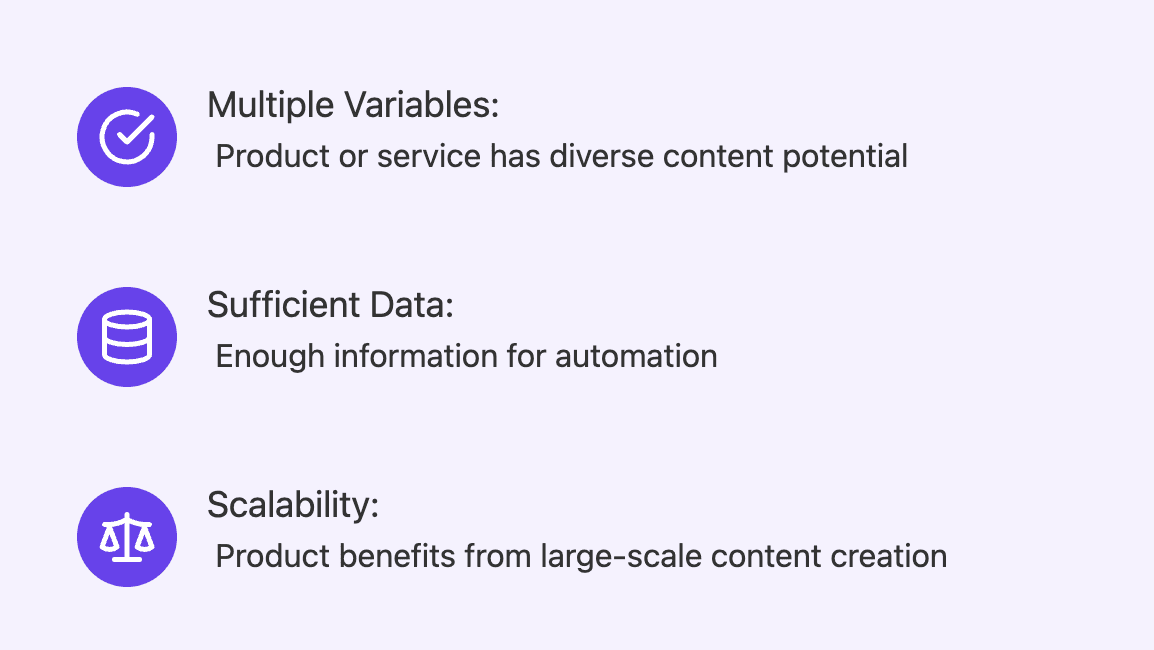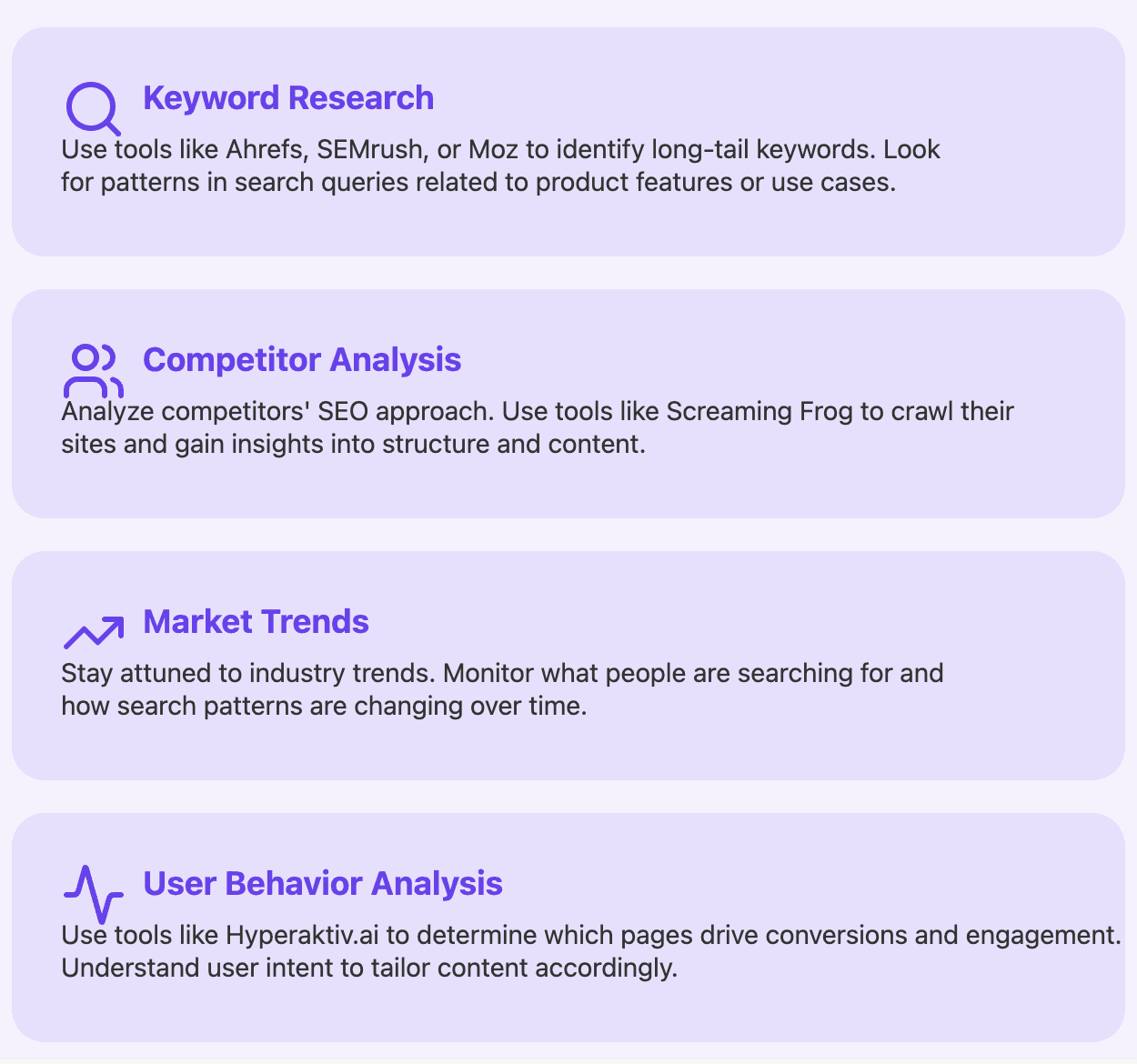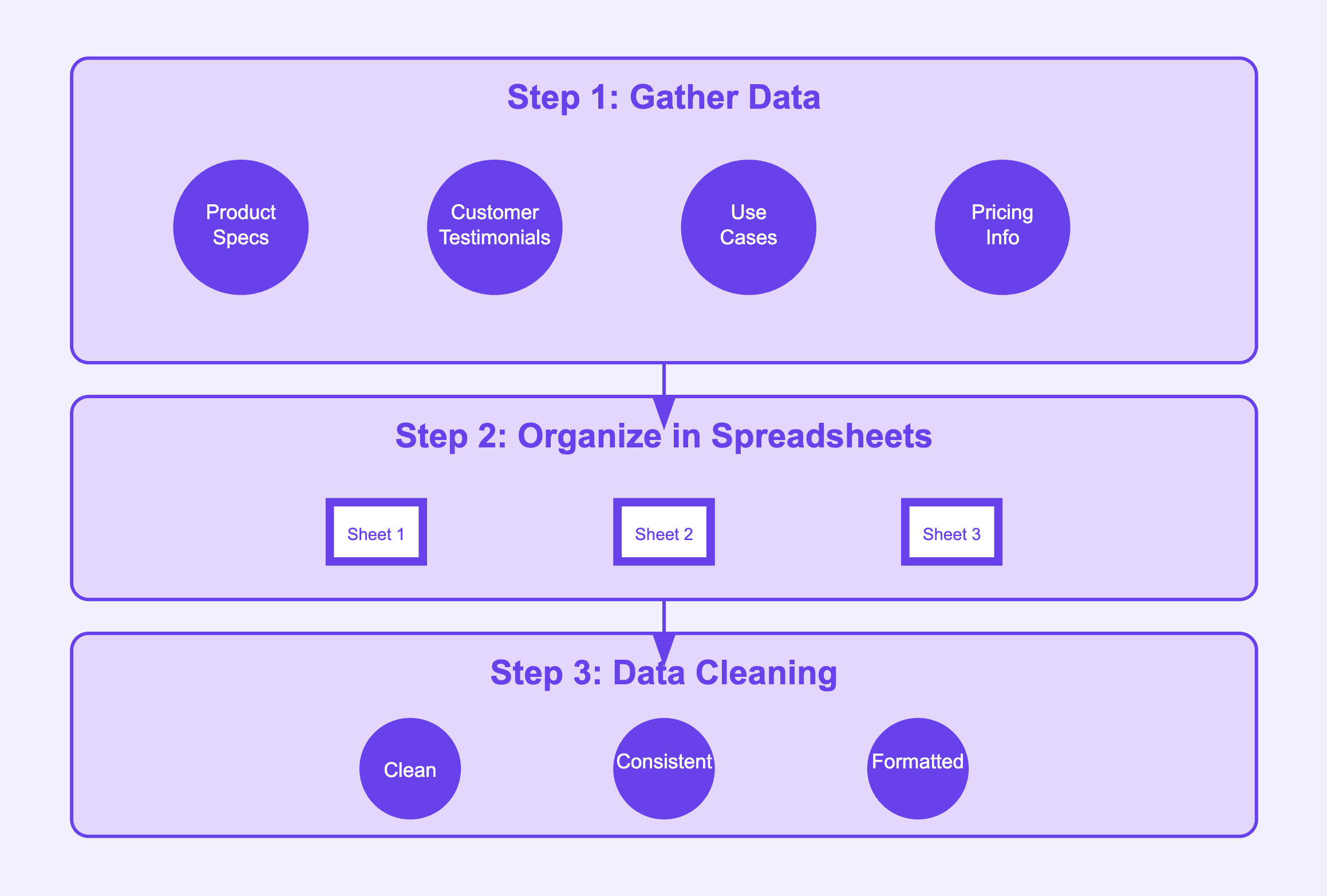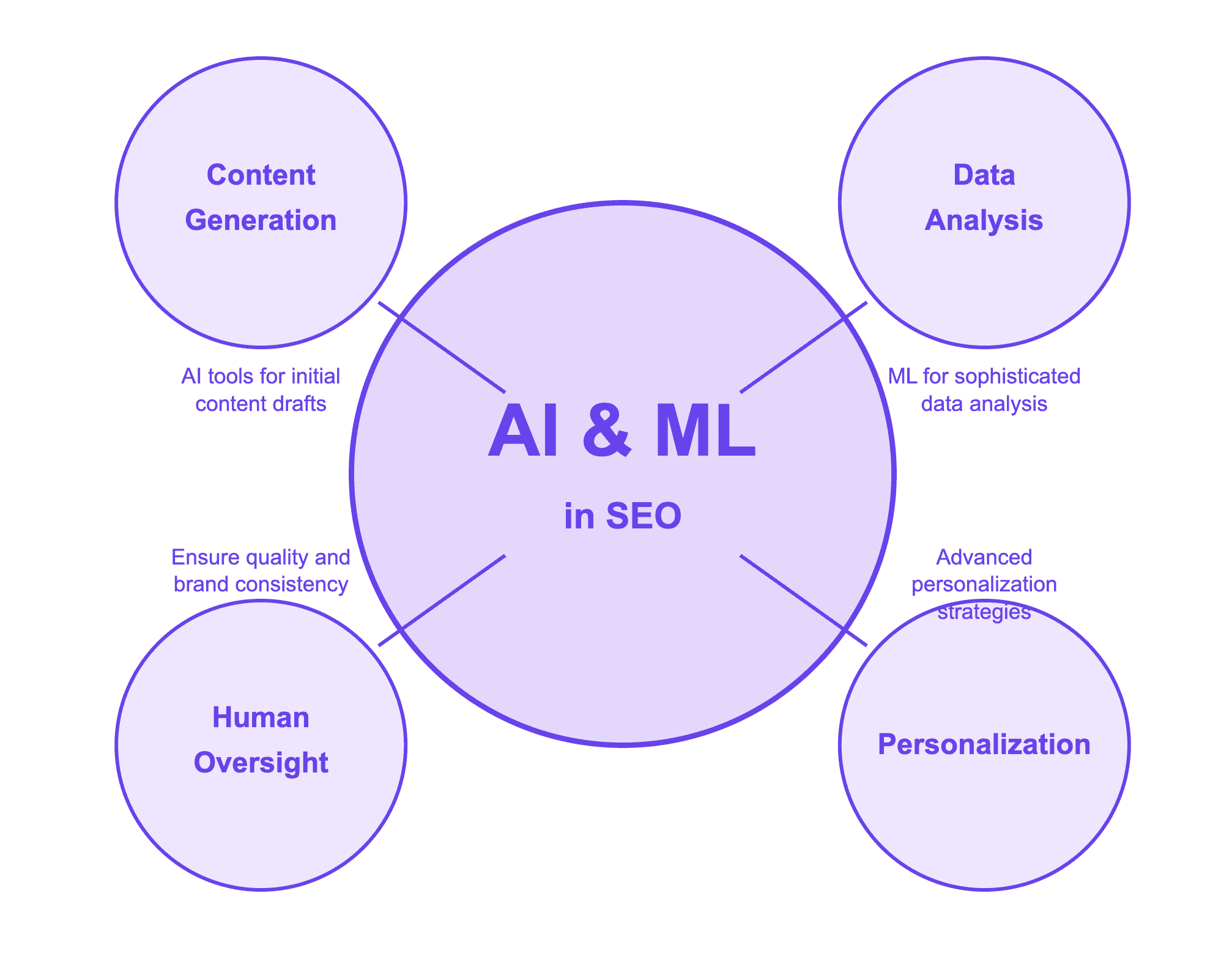
How to Implement Programmatic SEO for PLG SaaS: 15 Steps

par
Aleksa Mitrovic
24 sept. 2024
Identifiez et convertissez vos utilisateurs les plus importants
Créer un compte
Programmatic SEO has emerged as a powerful strategy for boosting online visibility, particularly for Product-Led Growth (PLG) SaaS companies.
This comprehensive guide, based on insights from Matija, founder of Omnius (a B2B Marketing Agency for SaaS), will walk you through the process of implementing Programmatic SEO effectively.

What is Programmatic SEO?
Before diving into the implementation, let's briefly define Programmatic SEO. It's an approach that leverages automation to create large-scale, data-driven content tailored to specific search queries. This method is particularly effective for businesses with products or services that have multiple variables, such as templates, integrations, or industries served.
Step 1: Assess Suitability

The first step in implementing Programmatic SEO is to determine if it's the right fit for your business. Consider the following factors:
Multiple Variables: Does your product or service have multiple variables that can be used to create diverse content? For example, Zapier has integrations with numerous apps, Vidio offers various video templates, and Canva provides design tools for different purposes and industries.
Sufficient Data: Evaluate whether you have enough data to work with for automation. This could include product features, use cases, customer data, or industry-specific information.
Scalability: Consider if your product or service can benefit from creating content at scale. If you are targeting a very niche market with limited variations, Programmatic SEO might not be the best approach.
Step 2: Set Clear Objectives
Before diving into implementation, it's crucial to define your goals. Are you focusing on short-term profitability or long-term growth? Your objectives will guide your strategy:
For Profitability: Focus on creating pages that are more likely to bring in converted customers. This might mean targeting high-intent keywords or creating content for stages closer to the bottom of the funnel.
For Growth: Prioritize pages that bring in the most engaged users. This could involve targeting a wider range of keywords and creating content that educates and nurtures potential customers through various stages of their journey.
Step 3: Conduct Thorough Research

Comprehensive research is the foundation of a successful Programmatic SEO strategy. Here's how to approach it:
Keyword Research: Use tools like Ahrefs, SEMrush, or Moz to identify long-tail keywords relevant to your product's variables. Look for patterns in search queries that you can map to your product features or use cases.
Competitor Analysis: Analyze how your competitors are approaching SEO. Are they using Programmatic SEO? What types of pages are they creating? Use tools like Screaming Frog to crawl competitor sites and gain insights into their structure and content.
Market Trends: Stay attuned to trends in your industry. What are people searching for? How are search patterns changing over time?
User Behavior Analysis: Utilize tools like Hyperaktiv.ai to determine which pages bring conversions and which bring engagement. This will help you understand user intent and tailor your content accordingly.
Step 4: Data Collection and Organization

Effective Programmatic SEO relies on well-organized data. Follow these steps:
Gather Data: Collect comprehensive data on your product's variables, features, use cases, and target industries. This might include:
Product specifications
Customer testimonials
Industry-specific use cases
Integration capabilities
Pricing information
Organize in Spreadsheets: Use tools like Google Sheets or Excel to organize your data. Create separate sheets for different variables or content types. This will make it easier to pull data for your content templates later.
Data Cleaning: Ensure your data is clean, consistent, and formatted correctly. This step is crucial for smooth automation later on.
Step 5: Create Content Templates

Developing flexible content templates is key to scaling your content creation while maintaining quality:
Template Structure: Create a basic structure for your content that can accommodate different variables. This might include:
Title
Introduction
Key Features
Use Cases
Benefits
Call to Action
Variable Placeholders: Within your template, use placeholders for the variables that will change based on the specific page. For example: "How [Product Name] helps [Industry] achieve [Goal]"
Maintain Quality: Ensure your templates are designed to create high-quality, valuable content. Avoid generic language that could make your content seem repetitive or low-value.
Personalization Elements: Include elements in your template that allow for personalization based on user intent or stage in the customer journey.
Step 6: Implement Automation
Now it's time to set up the automation that will power your Programmatic SEO:
Choose Automation Tools: Tools like Zapier, Make (formerly Integromat), or custom scripts can help automate the content creation process.
Data Integration: Set up systems to pull data from your spreadsheets into your content templates. This might involve using APIs or data connectors.
Content Generation: Create a workflow that automatically generates content based on your templates and data. This could include creating HTML pages, blog posts, or even product descriptions.
Quality Checks: Implement automated quality checks to catch any errors or inconsistencies in the generated content.
Step 7: Personalization Strategy
To make your Programmatic SEO truly effective, focus on personalization:
User Intent Mapping: Develop a system to match user intent with specific content types or variations.
Dynamic Content: Implement dynamic content elements that change based on user behavior or preferences.
A/B Testing: Set up A/B tests to optimize your content for different user segments.
Localization: If applicable, include elements that allow for easy localization of content for different regions or languages.
Step 8: Quality Control

Despite automation, maintaining content quality is crucial:
Manual Reviews: Implement a system for regular manual reviews of a sample of generated content.
User Feedback: Set up mechanisms to collect and act on user feedback about the content.
Continuous Improvement: Use insights from reviews and feedback to continually refine your templates and data sources.
Uniqueness Checks: Ensure each piece of content adds unique value, avoiding mere duplication with minor changes.
Step 9: Technical SEO Considerations
Programmatic SEO requires careful attention to technical SEO aspects:
Site Structure: Optimize your website's structure to handle large volumes of programmatically generated content. This might involve creating logical categories and subcategories.
Internal Linking: Develop a strategy for internal linking that helps both users and search engines navigate your content effectively.
Sitemap Generation: Automate the process of updating your sitemap as new content is created.
Page Speed: Ensure your server can handle the increased load and that pages load quickly despite the large volume of content.
Step 10: Integrate with Traditional SEO
Programmatic SEO works best when combined with traditional SEO strategies:
Cornerstone Content: Create high-quality, manually crafted content to build authority and relevance in your niche.
Link Building: Develop a link building strategy to boost the authority of your programmatically generated pages.
Social Signals: Implement social sharing features and encourage engagement with your content on social platforms.
Step 11: Implement and Monitor
With your strategy in place, it's time to launch and closely monitor performance:
Gradual Rollout: Deploy your Programmatic SEO strategy in phases, starting with a small subset of pages.
Analytics Setup: Use tools like Google Analytics, Google Search Console, and specialized SEO tools to monitor performance.
Key Metrics: Focus on engagement metrics (time on page, bounce rate), organic traffic growth, and most importantly, conversions.
Regular Reporting: Set up regular reporting to track progress and identify areas for improvement.
Step 12: Continuous Optimization
Programmatic SEO is not a "set it and forget it" strategy. Continuous optimization is key:
Data Analysis: Regularly analyze performance data to identify successful patterns and areas for improvement.
Template Refinement: Use insights from your data to refine your content templates and generation processes.
Expansion: As you see success, gradually expand your Programmatic SEO efforts to cover more variables or content types.
Step 13: Stay Updated with Algorithm Changes
Search engine algorithms are constantly evolving. Stay ahead by:
Industry Monitoring: Keep a close eye on SEO news and algorithm updates.
Adaptation: Be prepared to adapt your strategy quickly in response to major algorithm changes.
Quality Focus: Always prioritize content quality and user experience, as these are consistent priorities for search engines.
Step 14: Leverage AI and Machine Learning

As AI technology advances, consider incorporating it into your Programmatic SEO strategy:
Content Generation: Explore using AI tools for initial content drafts or idea generation.
Data Analysis: Leverage machine learning for more sophisticated data analysis and trend prediction.
Personalization: Use AI to create more advanced personalization strategies.
Human Oversight: While embracing AI, maintain human oversight to ensure quality and brand consistency.
Step 15: Focus on User Intent
Ultimately, the success of your Programmatic SEO strategy depends on how well it serves user intent:
Intent Research: Use tools like Hyperaktiv.ai and analyze user behavior to gain deep insights into user intent.
Content Alignment: Continuously refine your content to better align with identified user intents.
User Journey Mapping: Create content that supports users throughout their entire journey, from awareness to decision.
Feedback Loop: Implement systems to collect and act on user feedback, ensuring your content remains relevant and valuable.
Conclusion
Implementing Programmatic SEO for a PLG SaaS company is a complex but potentially highly rewarding process. By following these steps and continuously refining your approach, you can create a powerful engine for organic growth. Remember, the key to success lies in balancing automation with quality, always keeping user intent and value at the forefront of your strategy.
For more insights on this topic, check out the full interview with Matija: Programmatic SEO — A game changer for SaaS Growth.




